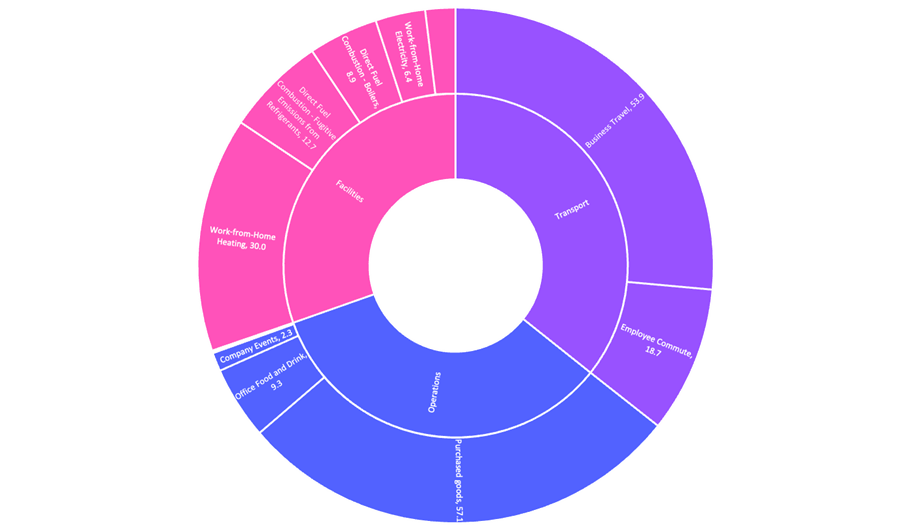Collectively, we need to drastically reduce our impact if we want to keep global warming to below 1.5 °C above pre-industrial limits and reduce the potentially catastrophic impacts of climate change.
Earlier this year we decided to take a proactive approach to address climate change and embarked on a journey to measure our own impact and make a plan to keep us in line with global reduction targets as we move towards a low-carbon economy.
Here, you can read about our sustainability and environmental responsibility journey over the last few months and plans for the future.
First we needed to know what exactly our impact was so we worked directly with carbon-analytics company Alectro to measure our emissions. Together with the Alectro team, we measured our carbon impact for FY21 (April 2021-March 2022) by using the GHG Protocol, the most widely used framework around the world.
The GHG Protocol measures emissions in three key categories, or Scopes, as they’re referred to (you can read more about these here). We measured everything we could reasonably and accurately measure across all three Scopes to give us the most up-to-date assessment of our impact.
This meant measuring obvious items like electricity and heating, difficult to measure items such as employee commutes and working from home, and the small but important items like food and drink consume and IT equipment. (you can see the full breakdown below).
Broadly speaking, we wanted to measure as much as we could so that we could be realistic in our approach to making reductions as we move towards net-zero.


During the period of analysis (April 2021 – March 2022), Brands2Life’s carbon emissions totalled 203.67 tCO2e.
The key contributors to the overall impact came from purchased goods (28%), business travel (26%), and heating when working from home (15%). Collectively, these made up 69% of the total impact. Based on an average of 171 full-time employees in 2021, this is a value of 1.19 tCO2e/employee.
What those numbers actually mean:
Operations emissions made up 34%. Purchased goods were predominantly the IT equipment we use, such as laptops, monitors, phones etc.
Transport emissions made up 35.6%. Business travel was 53.9 tCO2e while employee commute was lower than an average year because of COVID, but still contributed 18.7tCO2e.
Facilities emissions made up 30.4%. Working from home heating contributed 30 tCO2e and refrigerants leak contributed 12.7 tCO2e.
Rather than assigning spend-based emission factors to our supply chain, we’ll be interacting with it more directly. We have analysed our supply chain to understand which suppliers currently align with our strategy. Any who do not, we will encourage to transition to carbon neutrality and if they’re not willing to commit to similar targets then we’ll seek to move our supply chain.
The goal is to support other organisations with a similar outlook, and to make our supply chain as clean and transparent as possible.
This is only the first step of our net-zero journey. We see this as a three-step process:
1. We have started by measuring our impact and understanding where our emission hotspots are. This will help us to make some changes to reduce the impact immediately. We are also offsetting this impact so we are now a carbon neutral company.
2. By implementing short-term targets and measuring these year on year, we aim to become net-zero consistent as we align our reductions with science-based targets. We will release more about this once they’re finalised.
3. By 2030 at the latest, we will have reached a net-zero consistent state and will then move forward with more passive emission reductions that will take the company towards net-zero by mid-century.
In parallel we will make efforts to reduce our overall impact by supporting the United Nations Sustainable Development Goals, a blueprint to achieve a better and more sustainable future for all. Brands2Life emitted 203.67 Tonnes in a single year and aims to offset 204 Tonnes.
We asked employees to vote for their top three goals for guidance on which projects to support.
The top goals were:
Brands2Life is supporting three projects that best targeted these SDGs and a total of eight SDGs are directly supported across our chosen projects.
Solar thermal power plant, India
Implementation of a 50 MW large-scale grid connected solar thermal power project in Jaisalmer district, Rajasthan, India.
Project activity comprises state-of-the-art, environment friendly, solar thermal power generation using parabolic trough technology under the purview of large-scale, solar thermal power technology based projects implemented in India. This project activity estimates a supply of 118,866 MWh of net electricity to the grid per year and abates 1,131,600 tonnes of Carbon Dioxide emission.
Biomass Power Project, India
Implementation of a 20 MW biomass based power project at Siltara, Raipur.
The purpose of the project activity is to generate electricity using renewable biomass residues i.e. rice husk to reduce GHG (CO2) emissions. As biomass is a CO2 neutral fuel, the power produced by the local electricity company from renewable biomass will have zero GHG emissions.
To read more about these project and see our offset registry, please visit our public impact page.